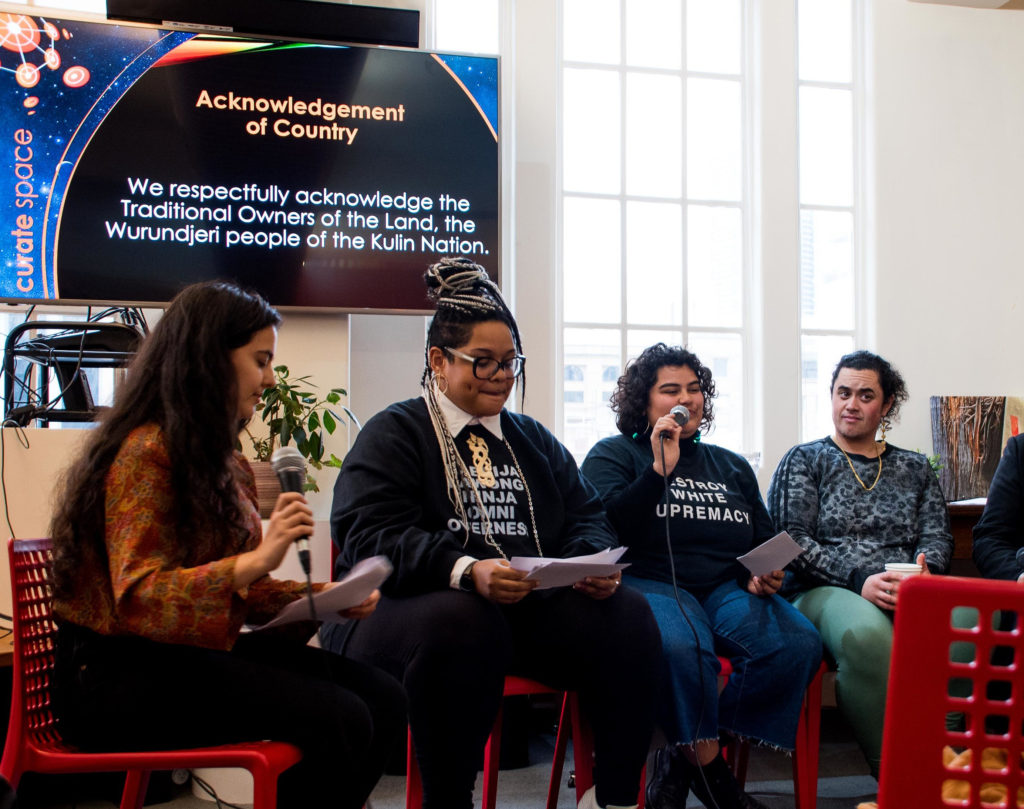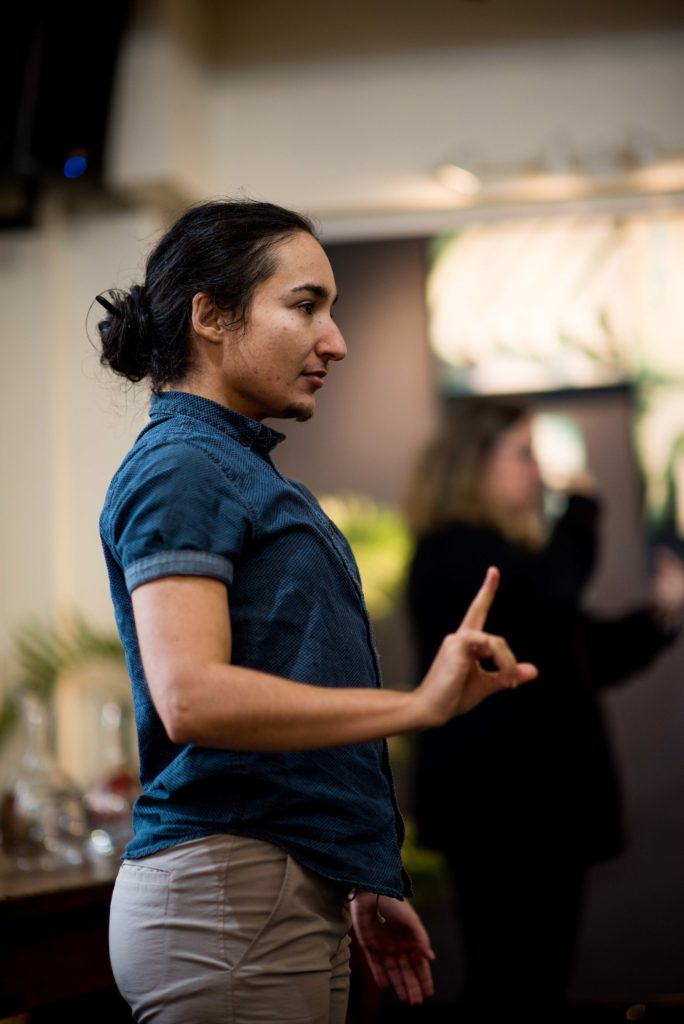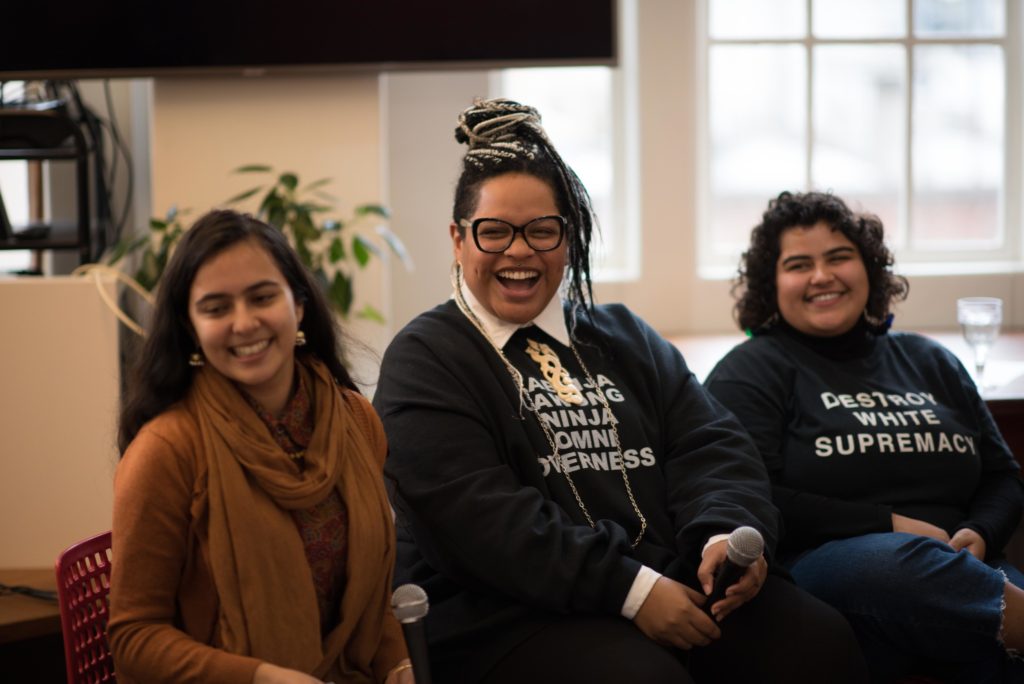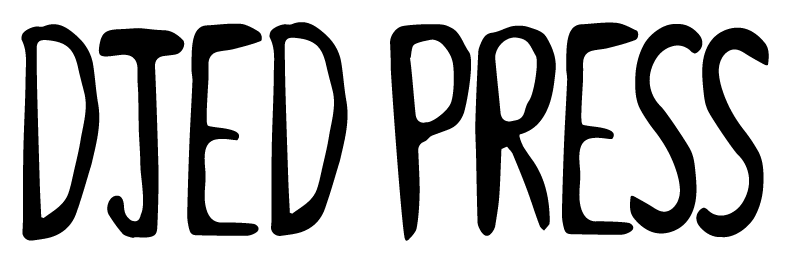How do things like racism, faith-based discrimination play out in LGBTIQA+ communities? What assumptions or stereotypes need addressing for QTIPOC*? What can be done to create better equity for QTIPOC?
These are just some of the questions that came up at the recent Switchboard event The QTIPOC Project presents: Race and Community Care, a four-person panel discussion featuring Bexx Djentuh, Rose Simonsen, Maddee Clark, and Nidaa, along with a performance by poet and movement artist Raina Peterson. Activist Tarneen Onus-Williams had been scheduled to be part of the panel, but was unable to attend as she’s up at Djap Wurrung country organising actions to save the sacred trees VicRoads is currently attempting to bulldoze in favour of a highway.

The proceedings began with what I consider to be both a unique and fitting performance for a discussion around politics and community—a performance with movement and dance by poet Raina Peterson.
Trained in classical Indian dance forms originating from Kerala, Raina’s work is derived from a rich historical underpinning of story-telling and drew a distinct narrative thread from the colonisation and oppression of antiquity, to the continued marginalisation that queer people face in their day-to-day lives within contemporary society. Their performance utilised the metaphor of a ‘Nautch girl’, a dancing girl, to examine broad concepts around race, identity politics and the reality of oppression through a lens that, while narrative, held a firm grasp on the reality of post-colonial conditions within the hearts and psyches of individuals from differing backgrounds. I was personally left deeply moved by the strength of the performance; Raina’s powerful ability to project vocally as well as their mastery of the dance juxtaposed to create a relevant, biting and wonderfully metaphorical performance and practice.

With no prior knowledge of who the panellists were or work they do in the community, I found the delivery and the intense, funny, often highly personal lived experiences of each highly relatable in differing constants. The four dove straight into deep and heady questions regarding the current visible discussions facing the QTIPOC community as individuals and as a whole, the reality being quite inseparable.
When asked what the panellists thought the main challenges facing QTOPIC are locally, Bexx outlined the ignorance from mainstream queer institutions to include QTIPOC people within visibly queer spaces; in these spaces, Bexx argues, already marginalised individuals are left feeling further ostracised due to a desire for the white queer community to see people of colour’s queer identity trumping over, in a sense, their racial identity.
“For some reason a lot of our culture is in the themes of their parties and gatherings, but [these spaces] don’t necessarily contain the people who have those lived experiences. I found that half of them didn’t even know the word QTIPOC—they limit themselves to LGBTQI for whatever reason. Apparently watching The L Word or Queer As Folk is enough for their education.”
In a way I have felt this: though I do not always actively identify for visible reasons as a person of colour, the dominance that white narratives hold within queer spaces, especially publicly, does not take a particularly trained eye to see or focus on.
Rose, a panellist I identified with greatly, discussed growing up somewhat disconnected from her community as a person of colour and feeling further disconnected from her culture following establishment and having an ingrained presence within white queer communities; I felt an empathetic sense of Rose outlining how individuals merely prioritised her for ‘what’ she is, the idea of what she is, as opposed to the distinct real nature of her actual identity.
“One of the main things is not being seen, or not seeing people who look like you,” she said. “It took me so long [to find people who were both POC and queer]. There was no representation in magazines, on TV, and if there were there was usually something wrong with the queer characters.
“Inclusion is a big issue. I’ve had times when I’ve applied for things—I think they really like the idea of who I am, like you’re queer, trans, this that, yeah we wanna be inclusive! and then [after they interview you] give the job to a white person.”
Maddee and Nidaa both outlined the importance of those comments and the emphasis community organisations could place in the establishment of QTIPOC-specific spaces, either within established queer spaces or existing aside from them.
“It’s not just about adding ‘diversity’ for flavour,” Maddee said. “Lots of organisations and collectives and community groups think it’s acceptable just to have just one person from a minority group. It’s important, especially if you’re thinking about institutional spaces or funding, to have space created within that for autonomy and for QTIPOC to gather together to facilitate that.”
Nidaa also spoke of the idea of QTIPOC being used as political pawns. “There’s always some narrative being pushed that we’re fighting, and that we’ve got to fight racism or we’ve got to fight a number of things,” she said. “Can we just live? Can we just exist in a space? Being used in that manner is quite isolating and it’s quite tiring. Sometimes we don’t want to fight, and that’s perfectly normal, that’s perfectly valid. Seeing ourselves celebrated for who we are in the same manner white people are would be fantastic to see.”

The panel then veered towards a discussion of healthcare and the medical establishment, and the problems currently facing the QTIPOC community in clinical settings. Nidaa’s experience of having clinicians—often white and able-bodied—poking and prodding at her life, the ceaseless questioning of ‘how can one be a lesbian and Muslim’ as opposed to taking her personhood into account, and seeing the duality as some kind of tragic trauma porn, is an experience rarely discussed in the public eye.
“You get that within healthcare, even when we’re not talking about LGBT issues,” she said. “You’re just talking about your traumas and your mental health and there’s always Oh, was that a cultural thing? And I’m like, how do I unpack this to my therapist, who’s supposed to be helping me, without sassing them? It’s a very uncomfortable position to be in.
“[It would be great] if they were coming without that judgment, without all these preconceived notions, because guess what? We’re not a monolith. We don’t all have the same stories.”
Maddee agreed that healthcare was one of the bigger offenders when it comes to this issue. They discussed current developments from peers within the Indigenous health sector in order the remove Indigeneity as a marker for health risk within clinical-based settings. “Aboriginal is not a risk factor,” they said.
“I got to an LGBT-friendly health service, and I’ve been tested there for diabetes like four times. I don’t have it. I don’t have diabetes in my family, I’ve never had any symptoms of diabetes. But when they see ‘Aboriginal’ on your file they’re like yep, this disease and this disease, we need to test you for all of them. For me it’s symbolic of a broader issue in healthcare provision, where your race is attached to assumptions.”
Rose brought up a crucial point about the intersection of race and fatphobia in health care. “Being a bigger woman going into healthcare services, people were always assuming things. I think race and being plus-sized or having a different body shape… My body was built this way; I’m completely healthy. I realised only recently how fatphobia stems from white beauty standards.”

Bexx outlined how as soon as one discloses their queerness to a health professional, the discussion veers immediately to stereotypical health risks such as drugs, STIs, etc., as opposed to more subtle and nuanced risks faced by QTIPOC people.
Racism and faith-based discrimination within LGBT communities was also discussed, with Nidaa stating the prevalence for individuals within queer communities to assume a person visibly of faith would hold homophobic tendencies before outing themselves—the idea of ‘homophobic before presumed gay’, a scenario deeply ironic and confusing for a community that prides itself on ‘acceptance’. Bexx told of a terrible, racist experience of her photo being used within a white queer space for a ‘jungle party’, demonstrating the ingrained racism and exclusionary attitudes that still pervade within white queer spaces, or what Rose later identified as white queers profiting from POC culture for ‘variety’. This, according to Bexx, emphasised the need for QTIPOC institutions to function as their own separate entities from white queer spaces. Maddee outlined how government programs initiated by the Andrews government demonstrated a false display of tolerance and acceptance towards QTIPOC communities while actively disenfranchising others.
Proposed ideas were developed regarding possible areas of improvement for the QTIPOC community in terms of improving a community directory, hiring of more QTIPOC individuals in specific positions and, to paraphrase Nidaa, the ability to find your ‘chosen family’ (I thought immediately of the ‘logical vs biological family’ quote from queer writer Armistead Maupin).
Coming from an unrelated variety of arts journalism background, this panel was a very heady and at the same time friendly and casual introduction for me into topics I had interest in but knew very little about—or thought I had known little about—in terms of lived experience as a queer, transgender or intersex person of colour. The discussions held were deeply informative and eye-opening especially for the individuals such as myself who, while being part of the QTIPOC umbrella in ways, may not have had prior knowledge of the issues discussed and the importance of community care.
*QTIPOC = Queer and Trans Indigenous Peoples and/or People of Colour
Cover image graphics and illustration © Dawn Dangkomen / Images © Amrita Sur Photography
About the author
With previous experience within journalism as a music writer and blogger, as well as an over-arching interest in topics relevant for queer people and people of colour, Alice/Alif Apfel Thomas brings a personal and honest perspective to the events concerning QTIPOC communities today.



